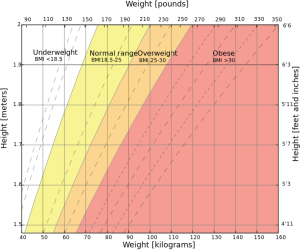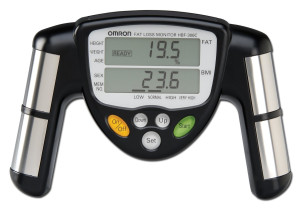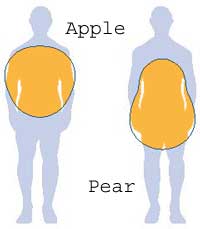
Body Mass Index or more commonly known as BMI is a standard unit of measurement that many health professionals use today to determine ideal ranges of weight based on your height. If it sounds familiar to you that's because you may have had this tested the last time you went for a physical. While many physicians still today display this chart in their offices, it's important to understand it's relevance. Instead of focusing on weight alone, determining body fat and hip to waist ratio figures is going to be more important in assessing one's overall health.

When it comes to body fat, 5-18% is ideal for men, while 12-25% is ideal for women. Keep in mind that fat is an essential macronutrient of the body, and having too little can be as bad as having too much. To find out where your numbers are at, it's a good idea to have a body composition analysis. A trainer can do this for you by calculating both your lean mass (muscle, tissue and bones weight) as well as body fat weight. This can be done simply with calipers or a handheld device. However, the most accurate, would be to test your weight before and after submerging yourself in water (hydrostatic testing) based on water displacement. This is a bit pricier, and the other methods will certainly suffice.
Once you have your body fat figures, it's a good idea to measure both your hips and waist circumference to figure out your hip to waist ratio. Unless your bearing child, failing to see your toes when you look down, is certainly a problem. This accumulation of weight in the mid-section is mostly visceral body fat around your vital organs that is linked to a host of coronary and obesity related diseases. This brings me to my next point: How are you carrying your weight?
Now that we know it's more than just the weight itself, but rather the type of weight and how it's distributed throughout the body, lets look at the example below using NFL running back, Darren Sproles.

For those of you non NFL fans, Darren is an electric 195lb running back for the Philadlephia Eagles packed into a 5'6" frame. Now while I can brag about the fact that I'm slightly taller than an NFL player, the 30lbs of what is quite obviously muscle is what separates the two of us...that and the fact that he can make an 89 yard punt return for a touchdown look easy, while juking 5 tackles on the way to the endzone!
Based on his height to weight ratio, Darren's BMI falls in the Obese category with a 31.5. Normal range is 18.5-24.9 However, I'm not going to be the one to tell the guy he's fat, and in reality, he's not at all. To more accurately assess him, we would need to see what his body composition was. This is a the ratio of lean body mass to body fat. It's realistic to assume he's 10% body fat and perhaps lower, but if this was the case, that would make him 175lbs of lean and mean.

Now let's take "John" who is 6'0", weighs 180lbs, making his BMI 24.4 As you can see, he falls within the normal range. He's taller, skinnier in appearance, and many would consider him healthy. The problem is that John doesn't workout, enjoys Pizza Hut, and the only touchdowns he's scoring is on Madden'16 for XBOX One. Despite all that, let's say John is lucky to be only 20% body fat which makes his lean body mass 144lbs. When we compare the two men, clearly Darren is carrying more muscle mass than John which is safer, yet John appears to be healthier than Darren based on a BMI chart.

Now let's get back to those hip to waist ratios again. You may have heard the terms "apple" and "pear" used to describe someone's physique. Technically, these are called android and gynoid bodies respectively. The pear, or gynoid physique is a safer way to carry ones weight, while the android body is more synonymous with diseases such as diabetes, for example. To determine your hip to waist ratio you must divide the hip circumference into the waist circumference. Let's say that Darren's waist is 32 inches while his hips are 41. This would mean he's at a .78 ratio...which is considered low risk. If John is 36 and 42 he's at .85 which is moderate risk, but still not as ideal as .78

So...the next time you step on the scale, think about why you're doing it. Common sense will tell you that you may need to lose a few pounds, but losing weight is not the ultimate answer. In fact, many healthy people initially lose body fat, but gain muscle so their weight doesn't move as significantly, yet they're a lot healthier. Eat clean, incorporate resisting training 2 or more times weekly, and focus on achieving a healthy body fat level. Whatever you BMI happens to be at that point, then so be it!
 Body Mass Index or more commonly known as BMI is a standard unit of measurement that many health professionals use today to determine ideal ranges of weight based on your height. If it sounds familiar to you that's because you may have had this tested the last time you went for a physical. While many physicians still today display this chart in their offices, it's important to understand it's relevance. Instead of focusing on weight alone, determining body fat and hip to waist ratio figures is going to be more important in assessing one's overall health.
Body Mass Index or more commonly known as BMI is a standard unit of measurement that many health professionals use today to determine ideal ranges of weight based on your height. If it sounds familiar to you that's because you may have had this tested the last time you went for a physical. While many physicians still today display this chart in their offices, it's important to understand it's relevance. Instead of focusing on weight alone, determining body fat and hip to waist ratio figures is going to be more important in assessing one's overall health.
 When it comes to body fat, 5-18% is ideal for men, while 12-25% is ideal for women. Keep in mind that fat is an essential macronutrient of the body, and having too little can be as bad as having too much. To find out where your numbers are at, it's a good idea to have a body composition analysis. A trainer can do this for you by calculating both your lean mass (muscle, tissue and bones weight) as well as body fat weight. This can be done simply with calipers or a handheld device. However, the most accurate, would be to test your weight before and after submerging yourself in water (hydrostatic testing) based on water displacement. This is a bit pricier, and the other methods will certainly suffice.
Once you have your body fat figures, it's a good idea to measure both your hips and waist circumference to figure out your hip to waist ratio. Unless your bearing child, failing to see your toes when you look down, is certainly a problem. This accumulation of weight in the mid-section is mostly visceral body fat around your vital organs that is linked to a host of coronary and obesity related diseases. This brings me to my next point: How are you carrying your weight?
Now that we know it's more than just the weight itself, but rather the type of weight and how it's distributed throughout the body, lets look at the example below using NFL running back, Darren Sproles.
When it comes to body fat, 5-18% is ideal for men, while 12-25% is ideal for women. Keep in mind that fat is an essential macronutrient of the body, and having too little can be as bad as having too much. To find out where your numbers are at, it's a good idea to have a body composition analysis. A trainer can do this for you by calculating both your lean mass (muscle, tissue and bones weight) as well as body fat weight. This can be done simply with calipers or a handheld device. However, the most accurate, would be to test your weight before and after submerging yourself in water (hydrostatic testing) based on water displacement. This is a bit pricier, and the other methods will certainly suffice.
Once you have your body fat figures, it's a good idea to measure both your hips and waist circumference to figure out your hip to waist ratio. Unless your bearing child, failing to see your toes when you look down, is certainly a problem. This accumulation of weight in the mid-section is mostly visceral body fat around your vital organs that is linked to a host of coronary and obesity related diseases. This brings me to my next point: How are you carrying your weight?
Now that we know it's more than just the weight itself, but rather the type of weight and how it's distributed throughout the body, lets look at the example below using NFL running back, Darren Sproles.
 For those of you non NFL fans, Darren is an electric 195lb running back for the Philadlephia Eagles packed into a 5'6" frame. Now while I can brag about the fact that I'm slightly taller than an NFL player, the 30lbs of what is quite obviously muscle is what separates the two of us...that and the fact that he can make an 89 yard punt return for a touchdown look easy, while juking 5 tackles on the way to the endzone!
Based on his height to weight ratio, Darren's BMI falls in the Obese category with a 31.5. Normal range is 18.5-24.9 However, I'm not going to be the one to tell the guy he's fat, and in reality, he's not at all. To more accurately assess him, we would need to see what his body composition was. This is a the ratio of lean body mass to body fat. It's realistic to assume he's 10% body fat and perhaps lower, but if this was the case, that would make him 175lbs of lean and mean.
For those of you non NFL fans, Darren is an electric 195lb running back for the Philadlephia Eagles packed into a 5'6" frame. Now while I can brag about the fact that I'm slightly taller than an NFL player, the 30lbs of what is quite obviously muscle is what separates the two of us...that and the fact that he can make an 89 yard punt return for a touchdown look easy, while juking 5 tackles on the way to the endzone!
Based on his height to weight ratio, Darren's BMI falls in the Obese category with a 31.5. Normal range is 18.5-24.9 However, I'm not going to be the one to tell the guy he's fat, and in reality, he's not at all. To more accurately assess him, we would need to see what his body composition was. This is a the ratio of lean body mass to body fat. It's realistic to assume he's 10% body fat and perhaps lower, but if this was the case, that would make him 175lbs of lean and mean.
 Now let's take "John" who is 6'0", weighs 180lbs, making his BMI 24.4 As you can see, he falls within the normal range. He's taller, skinnier in appearance, and many would consider him healthy. The problem is that John doesn't workout, enjoys Pizza Hut, and the only touchdowns he's scoring is on Madden'16 for XBOX One. Despite all that, let's say John is lucky to be only 20% body fat which makes his lean body mass 144lbs. When we compare the two men, clearly Darren is carrying more muscle mass than John which is safer, yet John appears to be healthier than Darren based on a BMI chart.
Now let's take "John" who is 6'0", weighs 180lbs, making his BMI 24.4 As you can see, he falls within the normal range. He's taller, skinnier in appearance, and many would consider him healthy. The problem is that John doesn't workout, enjoys Pizza Hut, and the only touchdowns he's scoring is on Madden'16 for XBOX One. Despite all that, let's say John is lucky to be only 20% body fat which makes his lean body mass 144lbs. When we compare the two men, clearly Darren is carrying more muscle mass than John which is safer, yet John appears to be healthier than Darren based on a BMI chart.
 Now let's get back to those hip to waist ratios again. You may have heard the terms "apple" and "pear" used to describe someone's physique. Technically, these are called android and gynoid bodies respectively. The pear, or gynoid physique is a safer way to carry ones weight, while the android body is more synonymous with diseases such as diabetes, for example. To determine your hip to waist ratio you must divide the hip circumference into the waist circumference. Let's say that Darren's waist is 32 inches while his hips are 41. This would mean he's at a .78 ratio...which is considered low risk. If John is 36 and 42 he's at .85 which is moderate risk, but still not as ideal as .78
Now let's get back to those hip to waist ratios again. You may have heard the terms "apple" and "pear" used to describe someone's physique. Technically, these are called android and gynoid bodies respectively. The pear, or gynoid physique is a safer way to carry ones weight, while the android body is more synonymous with diseases such as diabetes, for example. To determine your hip to waist ratio you must divide the hip circumference into the waist circumference. Let's say that Darren's waist is 32 inches while his hips are 41. This would mean he's at a .78 ratio...which is considered low risk. If John is 36 and 42 he's at .85 which is moderate risk, but still not as ideal as .78
 So...the next time you step on the scale, think about why you're doing it. Common sense will tell you that you may need to lose a few pounds, but losing weight is not the ultimate answer. In fact, many healthy people initially lose body fat, but gain muscle so their weight doesn't move as significantly, yet they're a lot healthier. Eat clean, incorporate resisting training 2 or more times weekly, and focus on achieving a healthy body fat level. Whatever you BMI happens to be at that point, then so be it!
So...the next time you step on the scale, think about why you're doing it. Common sense will tell you that you may need to lose a few pounds, but losing weight is not the ultimate answer. In fact, many healthy people initially lose body fat, but gain muscle so their weight doesn't move as significantly, yet they're a lot healthier. Eat clean, incorporate resisting training 2 or more times weekly, and focus on achieving a healthy body fat level. Whatever you BMI happens to be at that point, then so be it! 